We learn how to work with liquid mushroom cultures as The Mushroom Guide with Benedict Noel continues.
Catch up with Parts 1, 2, 3, 4, 5, 6 and 7 first.
Maintaining your own mushroom culture library is a time-saving and rewarding experience. It takes some time to get the hang of it, but there are methods that you can use without too much equipment. The main piece of equipment that you’ll need is a pressure cooker.
In general, people use two mediums for storing their cultures: agar or liquid cultures. In the mushroom community, liquid cultures generally have a bad rap since it’s harder to detect when they have contamination. However, using some simple steps you can ensure your liquid cultures remain contaminant free, even when you’re not working in a sterile environment.
Working with liquid cultures
What you need:
- a pressure cooker that can reach 15PSI
- jars with an airport lid
- syringe and needle (preferably 16+ gauge)
- alcohol wipes or alcohol spray
- lighter
- gloves
The easiest way to create your own liquid cultures is by starting with a clean culture from a reputable supplier and then expanding it into more liquid culture. The steps involved are:
- Add liquid culture recipe to your airport jars, typically consisting of tap water plus some sugar/nutrients
- Pressure cook the airport jars to sterilise the liquid culture
- Add a small amount of master culture to sterilised liquid culture
- Wait until the culture grows out, then use it to inoculate grain spawn or your fruiting substrate
Adding liquid culture to airport jars
This step is very simple, the only part that takes a bit of trial and error is working out which recipe works best for the mushroom that you’re trying to grow. For oyster mushrooms and shiitake, a simple recipe is tap water and maple syrup. Simply add 1 tsp of pure maple syrup to 1 cup of hot water, give it a mix and add it to your jars with airport lids screwed on. I try to fill my liquid culture jars fairly close to the top, leaving about 5cm (2 inches) of air. This will make it easier to draw liquid out with a syringe and it also allows for some evaporation.
It’s also a good idea to add something to your jars to break up the mycelium. Professionals use a stir bar and put their culture on a magnetic stir plate, but you can add some marbles or broken glass to the jar. Adding this will help your break apart large clumps of mycelium in order to help your culture grow faster and prevent it clogging the needle when you suck it into a syringe.
It’s a good idea to cover the top of your jars with aluminium foil before pressure cooking them. This stops the filter from getting too wet and also means that the jars are protected from exposure to contaminants until you’re ready to remove the alfoil.
Pressure cook the liquid culture
Add the jars to your pressure cooker and bring them to 15 PSI for approximately 15-20 minutes. Read the instructions on your pressure cooker and always remember to fill it above the base plate with water. Leave the culture to cool to room temperature. It will probably take several hours for this to happen and I usually let it cool overnight.
Add some mother culture to the liquid culture
Once you’ve let your jars cool, get your master culture, alcohol wipes and lighter ready. Shake your master culture vigorously to break up the mycelium as much as possible. If it’s the first time that you’re using the syringe needle, you won’t need a lighter since the needle will be sterile. Take the alfoil off the top of your first jar and push the needle through the self-healing injection port and pump a small amount of liquid culture (1-2 ml) in the jar. Repeat this with all of the jars that have been pressure cooked.

Airport lids ready for inoculation with liquid mushroom cultures. Credit: The Mushroom Guide
If you’re not using alfoil, it’s a good idea to wipe the injection port with an alcohol swab prior to sticking a needle through it. Alternatively you can spray it with your alcohol spray (70% alcohol/methylated spirits, 30% water).
If you’re reusing a needle for your syringe, you’ll need to sterilise the needle prior to use. Simply connect the needle to the syringe and hold the syringe over a flame moving it back and forth until the needle is red hot. You can then squirt a small amount of culture out of the needle to cool it down, or rub the needle with an alcohol wipe.
Put it on shelf and wait for it to grow
The majority of mushrooms grow best at a temperature around 25C, outside of this they’ll grow a little slower. I usually leave my jars on a shelf indoors for the first 4-5 days without disturbing it while the mycelium enters growth mode. You should see the mycelium slowly start to grow as it consumes the sugar. After this resting period, swirl the culture every few days to introduce oxygen into the liquid and to break up the mycelium.
Once the mycelium is taking up a large amount of the volume of the jar, vigorously agitate the liquid culture so that the mycelium is as broken up as possible, tilt the jar so that the liquid culture comes up against injection port and, with a sterile syringe and needle, suck the liquid culture into the syringe until it’s full. Your syringe is now ready to inject into grain jars, transfer to agar or share with friends.
In the next instalment, we’ll be looking at working with agar cultures.
Based on an original post available here by Benedict Noel at The Mushroom Guide.
 About the author
About the author
The Mushroom Guide is written by Benedict Noel from Perth, Western Australia. He’s been hooked on mushroom growing since watching this TED talk in 2015 and has been building his knowledge and experience ever since. Since starting out, he’s helped run a couple of cultivation courses, given presentations at festivals and grown a wide variety of mushrooms, from oyster and shiitake to pioppino and chestnut.

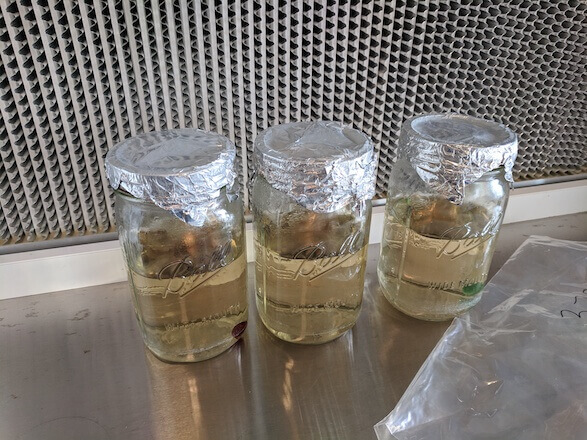
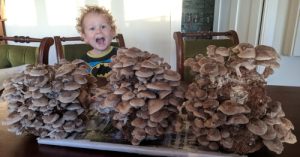
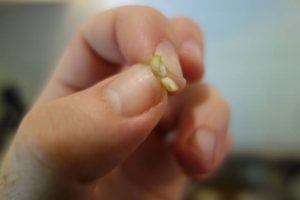
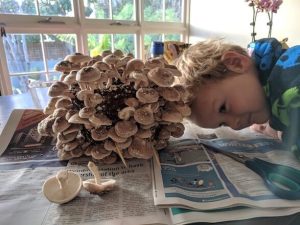

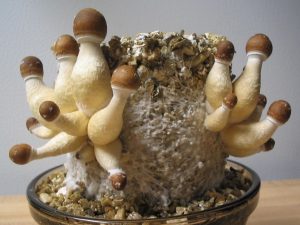
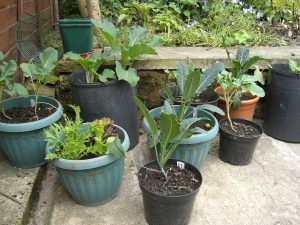
5 Comments
I have made and used most of my liquid culture my question is can i make new culture in the same manner from this culture that i made (by making liquid and drawling the culture i made and injecting it into new jar?) thanks
Hey Chris, yep this is fine to do! Professionals always go back to the “master culture to create new liquid culture from, but it should be fine doing a direct transfer like you’re suggesting.
Hey Chris. I created some LC from a MSS exactly one month ago. I can see mycelium but it is just barely covering the bottom of the jar. Everything I read tells me it should be covering most of the jar by now. Is it ok that it is growing slowly? Do you know what would cause such slow growth?
Hey Ray, what type of mushroom are you cultivating and what temperature are you keeping it at? Mycelium grows at different rates, but if it’s stalled and it’s not too cold, there’s most likely a problem with either the LC mix or the culture.
Hi Chirs..I made some LC for pink and king oyster about 2 months ago. I have the KO lc stored in the fridge and the Pink at regular room temp as i live in the Caribbean. I saw growth in the lc jars. However I inoculated some brf and vermiculite about 5 days but not seeing any growth as I would have seen from jars I innoculated from the mother culture.
What do you think went wrong…I’m wondering if the lc I made was viable…it’s seem fine looking.
Thanks much.
Lisa